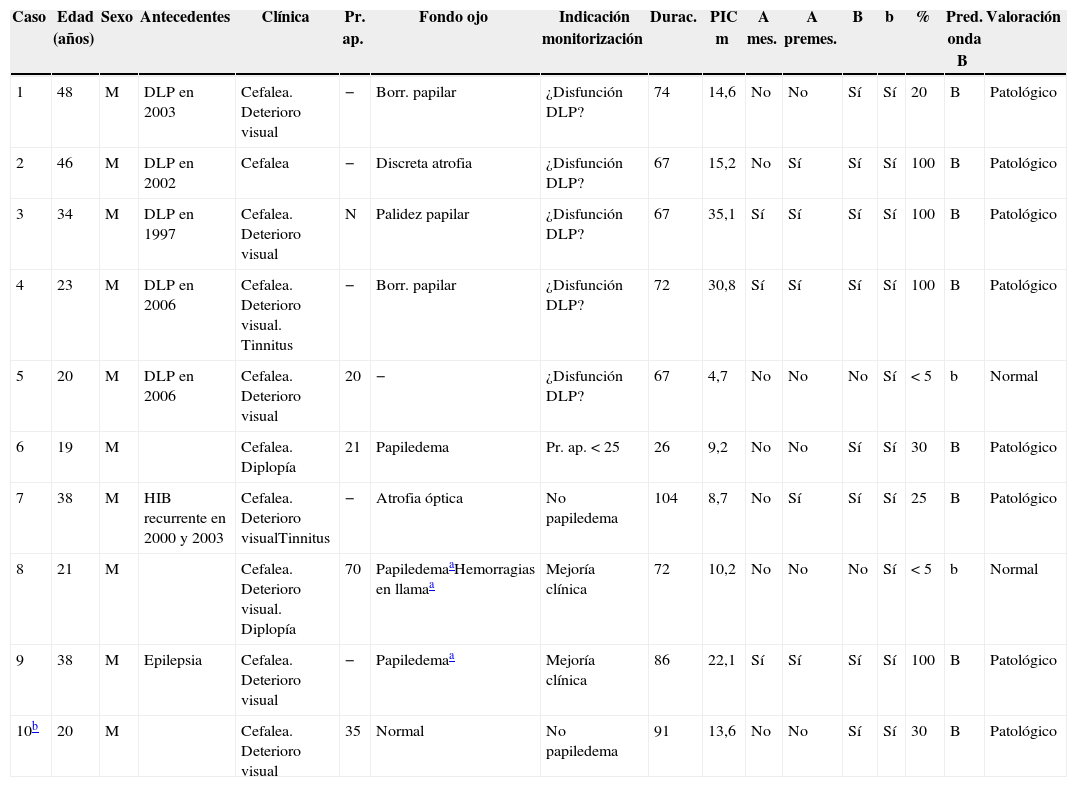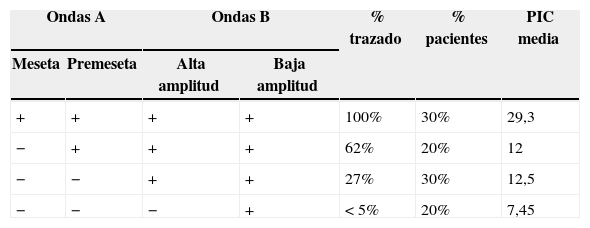Evaluar la utilidad del análisis del registro de presión intracraneal (PIC) en el diagnóstico de la hipertensión intracraneal benigna (HIB).
Material y métodosDiez pacientes con sospecha clínica de HIB en los que no se cumplen por completo los criterios diagnósticos. Se recogen los datos demográficos, clínicos y radiológicos, así como los datos de monitorización de la PIC y las complicaciones relacionadas con el procedimiento. Se evalúan resultados clínicos a los 6meses de la intervención.
ResultadosTodos los pacientes fueron mujeres jóvenes. La PIC media no fue superior a los 250mmH2O en 5 de los 8 pacientes con registros patológicos. El análisis morfológico del trazado evidencia ondasA en un porcentaje elevado de pacientes (62,5%), correlacionándose en general con PIC media más elevada, aunque esta situación no se correspondió de forma sistemática con presencia de papiledema. Las ondasB de alta amplitud estuvieron presentes en todos los registros. La amplitud del registro fue superior a 5mmHg en la mayoría de los casos considerados patológicos. Todos los pacientes tratados conforme a los criterios de monitorización de PIC experimentaron mejoría tras la intervención. No hubo complicaciones relacionadas con el procedimiento de monitorización.
ConclusionesLos datos clínicos y de exploración son en ocasiones insuficientes para establecer el diagnóstico de HIB, especialmente en los casos en que el paciente ha sido tratado médica o quirúrgicamente con anterioridad. La monitorización de la PIC es un método seguro y fiable, útil en el diagnóstico de esta entidad. Es imprescindible un análisis morfológico del trazado, ya que la PIC media es un dato de escasa utilidad, en tanto que la presencia de ondasA y B de alta amplitud se relaciona con una buena respuesta a la derivación. La amplitud del trazado expresa la complianza cerebral y es un dato relacionado también con respuesta a la derivación.
To analyse the usefulness of intracranial pressure (ICP) monitoring in pseudotumor cerebri (PTC).
Material and methodsTen patients with suspected PTC, but having incomplete criteria for the syndrome, on whom ICP monitoring was performed. Demographic, clinical and radiological data were collected, as well as ICP monitoring data and related complications. Results were evaluated 6months after surgery.
ResultsIn relation to demographics, all patients were young females. Mean ICP was less than 250mmH2O in 5 of 8 patients with pathological monitoring. Most patients (62.5%) showed A waves; these were related with higher mean ICP, but not always with papilloedema. All recordings showed high amplitude B waves. Most pathological recordings showed wave amplitudes superior to 5mmHg. There were no complications related to the monitoring technique.
ConclusionsClinical and lumbar opening pressure data are not enough to establish PTC diagnosis correctly, especially if patient has been treated previously. Monitoring using ICP is a valuable, safe tool, and very useful in this syndrome. Mean ICP could be normal even with pathological recordings. Morphological analysis is necessary to establish diagnosis. A and B waves are highly related to shunt response. Wave amplitude is related to brain compliance and to shunt response as well.
Article

If it is the first time you have accessed you can obtain your credentials by contacting Elsevier Spain in suscripciones@elsevier.com or by calling our Customer Service at902 88 87 40 if you are calling from Spain or at +34 932 418 800 (from 9 to 18h., GMT + 1) if you are calling outside of Spain.
If you already have your login data, please click here .
If you have forgotten your password you can you can recover it by clicking here and selecting the option ¿I have forgotten my password¿.

















